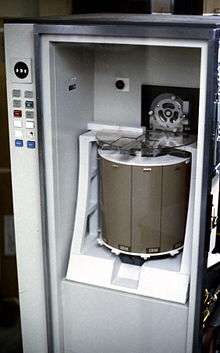IBM 2321 Data Cell

The IBM 2321 Data Cell announced in April 1964 was a direct access storage device for the IBM System/360. It could hold up to 400 million bytes of data, with an access time of 95 milliseconds to 600 milliseconds, depending on the addressed strip position and data arrangement in each data cell..[1]
Characteristics
The 2321 housed up to ten removable and interchangeable data cells. Each data cell contained 200 strips of magnetic tape, which were the basic recording media. The total storage capacity was 400 million bytes or 800 million decimal digits. Up to eight 2321s could be attached to the IBM 2841 Control Unit, allowing an overall capacity of over 3 GB.[2] It was a successful device—notwithstanding the complex mechanical movements to pick, read and return a strip to a bin.
In comparison to the contemporary IBM 2311 Disk Device, the IBM 2321 Data Cell Device held 55 times more data, while being only 7 times slower (85ms and 600ms access times respectively). One fully loaded IBM 2841 Control Unit connected with eight IBM 2321 Data Cell Devices would require an equivalent of 441 IBM 2311 Disk Devices, connected to 56 IBM 2841 Control Units.
The Data Cell made use of 3 concurrently operating separate seeking systems; a servo-hydraulic one to rotate the bins to select the proper subcell, and two solenoid driven ones; one to select the correct strip tab of the 10 in the subcell, and the other to select one of the 5 head positions, for the 20 element head (100 tracks per strip). The hydraulic fluid, Mobil DTE Light, a machine tool circulating oil, was pressurized at 1500 psi and despite a lot of folklore about oil leaks, they were very rare. The oil sump held 5 US gallons (19 l).
Although its storage medium was tape, the 2321 was a direct access storage device which could directly access a record rather than scan all the tape to find a record as would a conventional tape drive. IBM's System 360 operating system addressed the 2321 as a direct access storage devices, i.e., a disk drive, with a 6-byte seek address of the form ØBBSCH (hexadecimal) where the first byte is zero and the remaining bytes address the Bin (i.e., cell), Bin (i.e., sub-cell), Strip, Cylinder and Head.[2][3]
The 2321 was whimsically known as the "noodle picker" since the removable magnetic strips were flexible and resembled lasagna noodles.[4]
References
- ↑ IBM Archives - 2321 data cell drive
- 1 2 IBM System Reference Library, IBM System/360 Component Descriptions, Form A26-5988
- ↑ Generically, at the OS level, IBM defined the six bytes as BBCCHH, for Bin, Bin, Cylinder, Cylinder, Head and Head respectively.
- ↑ The 2321 Data Cell & Joe Rufin
External links
- The IBM 2321 Data Cell Drive at Columbia University
- Shugart, Alan; Tong, Yang-hu (1966), "IBM 2321 data cell drive", Proceedings of the April 26–28, 1966, Spring joint computer conference, New York City, New York: Association for Computing Machinery (ACM): 335–345, (subscription required (help)) External link in
|publisher=(help) - The IBM 2321 Data Cell Drive for portions of IBM manual.
- Close up photo of Data Cell drive